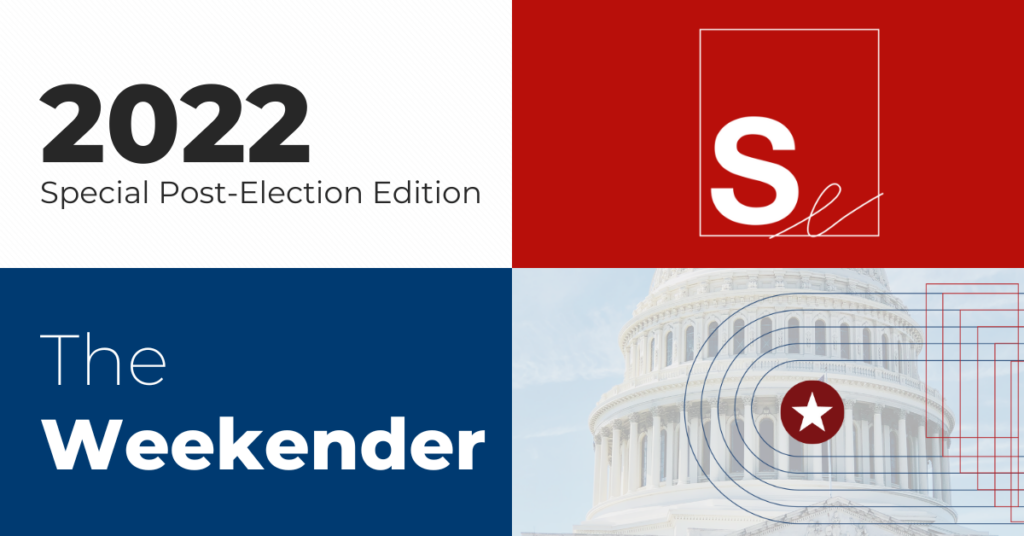WELCOME BACK TO VETERANS DAY AND A SPECIAL POST-ELECTION EDITION
Welcome back to a Special Edition of The Weekender… where we are breaking down all the 2022 midterm election results for you below—including impacts on the U.S. Senate, U.S. House of Representatives, and state capitals. The bottom line: Americans are not happy with how things are going (68% believe we are on the “wrong track”) but are not ready to make big changes to address that feeling. Plus—what does the world think about the midterm elections? We have the answers and more below in a special election edition of The Weekender. Be sure to come back next week for more results, continued analysis, and a look at how the election stands to impact issues and policymaking in the Lame Duck and the coming year. Thank you for joining us.
A Quick Message: Thank a Veteran… before we dive into the midterm election news of the week, we want to take a moment: November 11th once again marks Veterans Day, a time to honor the sacrifice and dedication of our men and women in uniform. Not only is this a great time to thank a current or former service member, but it’s also a great reminder of why we need to support veterans in the workforce after they return to civilian life.
The Big Picture
As post-midterm election results continue to be tabulated and control of both houses of Congress hangs in the balance, some results are apparent.
-
The much-hyped red wave became a soft trickle as results rolled in.
-
Despite record campaign spending and wall-to-wall news coverage, the election results show that Americans are near evenly divided into two spheres. The House changes from one slim majority to another, even in the wake of new districts. The yet-to-be-called Senate will end up somewhere between 51 R – 49 D, 50 – 50, and 49 R – 51 D.
-
At the state level, every incumbent governor on the ballot was re-elected (outcomes in very close gubernatorial races in Arizona and Nevada may change this). Generally, red states got redder and blue states got bluer.
-
The states with the election’s closest statewide contests are a familiar list: Arizona, Georgia, Michigan, Nevada, and Michigan. These are the same six states President Biden won by less than 3%.
Bottom line: Americans are unhappy with how things are going (68% believe we are on the “wrong track”), but they are not ready to make significant changes to address that feeling. It’s reasonable to conclude that neither side made a strong enough case that they will get the country on the right track – or voters have significant reticence about what “the other guys” will do if they are in power.
The Big Races
-
Florida Governor Ron DeSantis was the night’s overwhelming winner after being returned to the Governor’s Mansion by a historic 20-point margin in the now “purple-to-red” Sunshine State.
-
The biggest loser was Donald Trump–having notched sub-par results in high-profile U.S. Senate races. Victories by J.D. Vance in Ohio and Ted Budd in North Carolina were the only election-night highlights for the former president in the Senate races he heavily influenced the GOP nominee. Arizona’s Blake Masters is trailing, and Georgia’s Herschel Walker is facing a run-off. Dr. Mehmet Oz lost to Lt. Gov John Fetterman in Pennsylvania, and retired general Don Buldoc lost to Maggie Hassan in New Hampshire.
-
Majority control of the U.S. Senate is even more in doubt–a one-seat margin that could tilt towards either party is a strong possibility, as well as maintaining the 50-50 status quo (which gives Democrats control with VP Harris as the tie-breaking vote).
-
In fourteen closely watched U.S. House races, six saw the Trump-endorsed candidate defeated, three had Trump victories, and five remain undecided at the time of this writing.
-
Although majority control of the House is expected to shift to the GOP once final vote counts are tallied, the once-projected double-digit gains for Republicans did not materialize, creating anticipated leadership battles that wouldn’t have existed otherwise.
A quick snapshot of competitive gubernatorial races adds to the view that Republicans underperformed, and Democrats held their ground and, in a few cases, scored stronger-than-expected wins, including Gretchen Whitmer in Michigan, Kathy Hochul in New York, and Josh Shapiro in Pennsylvania.
The U.S. Senate

- The U.S. Senate elections started out with eight highly watched races, including Michigan, Wisconsin, and Pennsylvania’s now-flipped Senate seat, which was won by Democrat candidate John Fetterman.
-
With Pennsylvania flipping from R to D and Alaska’s still undecided three-way race coming down to two Republicans, whichever party wins two out of three of the remaining undecided states will control the Senate. Days after Election Day, the results from mail-in ballots are still coming in, and the Senate races have all come down to Arizona, Nevada, and Georgia.
-
Arizona Democrat incumbent Mark Kelly has a 5-point lead over Republican candidate Masters, Nevada Republican Laxalt has a less than a 1-point lead over Democrat incumbent Cortez-Masto. Georgia Democrat incumbent Warnock and Republican candidate.
-
Walker and Warnock will face off in a December 6 runoff since neither achieved a majority.
-
Split-ticket voters in states like New Hampshire and Georgia also made a difference, voting for a gubernatorial candidate in one party and a senate candidate in another.
-
One strong takeaway from the House and Senate mid-term election results is that while national parties drive election narratives, individual candidates make the difference in winning in competitive states and districts.
The U.S. House of Representatives

The State Capitals
- In state-level races, all eyes were on who will control the state capitals with 6,278 legislative seats up and 36 gubernatorial races on the ballot.
-
Tuesday’s election continued the trend of state governments moving toward single-party control. Coming into the election, 23 state capitals were under full Republican control and 14 were controlled by Democrats. After the election, those numbers are 23 and 18, respectively. A slim but meaningful increase for Democrats. Nine capitals have divided control after the midterm (Democrats consolidated control in Maryland, Massachusetts, Michigan, and Minnesota). With 41 states now under the coveted political “trifecta”, single-party control is showing a steady increase in popularity.
-
With every incumbent governor on the ballot re-elected (Arizona and Nevada may change this), voters appear to be more in sync with their state leaders than federal elected officials. With the Alaska three-way general election being led by two Republicans, 17 Republicans and 17 Democrats have been elected governor. The races in Arizona and Nevada are still undecided.
INTERNATIONAL SPOTLIGHT
All Eyes on America
As election results finish trickling in, many in Europe are expressing their relief at the absence of election violence and what looks like the ongoing health of American democracy. The midterm election results will provide some short-term stability in America’s efforts to isolate Russia and support Ukraine. The initial weaker-than-expected showing by Republicans was also celebrated by much of Europe; though, many anticipate new Trumpism attempts and extremism from political parties to continue to unfold, regardless of who is in power. As the U.S. elections continue to reveal more insights, governments around the world will continue to analyze the results for clues on future U.S. policies in the near term and how the 2024 presidential election may pan out. It’s no surprise that the world looks to the U.S. as a leader and a country that set the democratic bar for the rest—and this election is no different. Read more in Bloomberg.
DATA POINTS
- 168 million: The number of Americans who are eligible to vote in the midterm elections.
- 132: The number of statewide ballot measures that were decided by voters in 37 states.
- 1%: The percentage of top donors as measured by income has accounted for 38% of the total amount spent on federal races this election.
- 63,000: The number of registered service members, veterans, and family members who worked in the election this year through the Vet the Vote initiative.
- 68%: The percentage of voters in the exit polls who feel democracy is under threat in the U.S. This is true for both Democratic voters at 71% and Republican voters at 65%.
- 196: The number of military veterans who were on the House and Senate ballots this year. Representing the largest field of individuals with military experience running for office in a decade.
- 211%: The percentage increase from early voters in Georgia on the same day in 2018. The record early voting turnout has shattered previous midterm records by 50% or greater during every day of early voting.
- $880 million: The money that American billionaires have funneled into the elections as of last week, accounting for 7.4% of all money raised by federal candidates, political parties, and political action committees.
FEATURED TWEET
Elections and anxiety often go hand in hand. Here are some evidence-based strategies that can help you cope. https://t.co/Bu9Bq5AVqh pic.twitter.com/WkF7ClDpyA
— The New York Times (@nytimes) November 8, 2022










